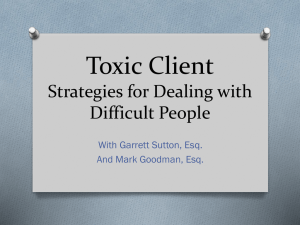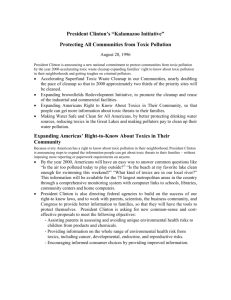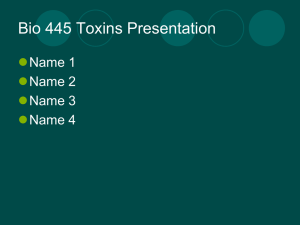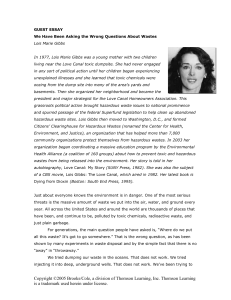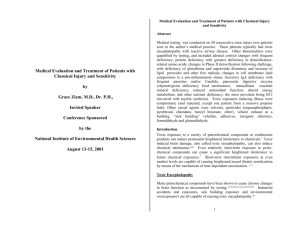GEI toxic politics
advertisement
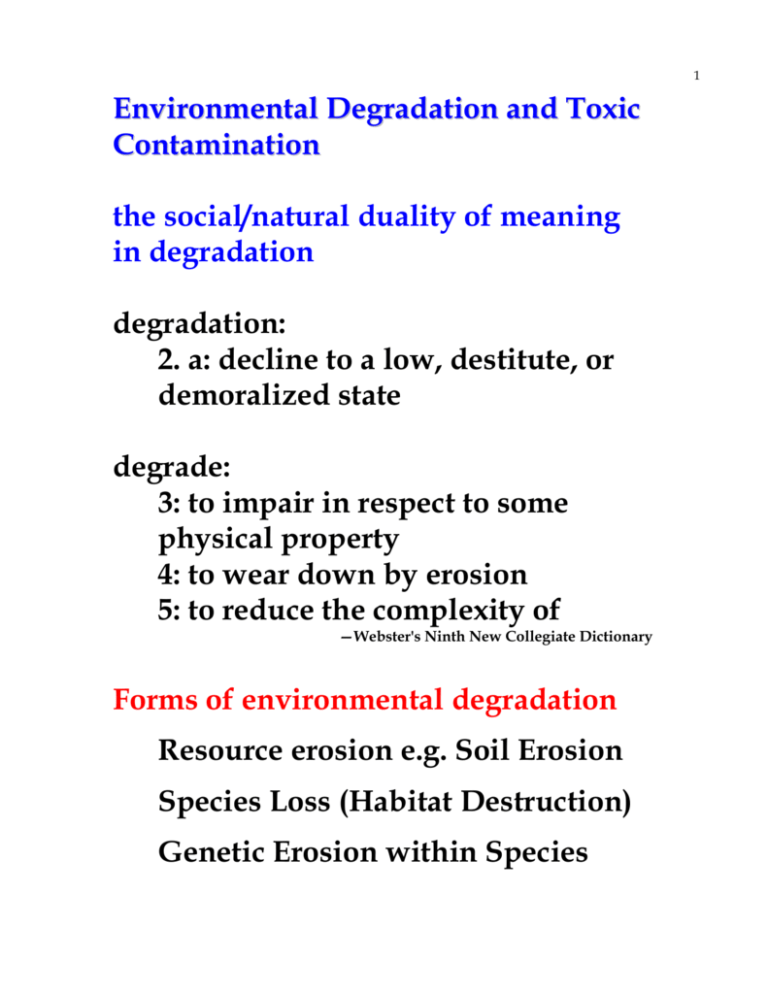
1 Environmental Degradation and Toxic Contamination the social/natural duality of meaning in degradation degradation: 2. a: decline to a low, destitute, or demoralized state degrade: 3: to impair in respect to some physical property 4: to wear down by erosion 5: to reduce the complexity of —Webster's Ninth New Collegiate Dictionary Forms of environmental degradation Resource erosion e.g. Soil Erosion Species Loss (Habitat Destruction) Genetic Erosion within Species 2 Climate Change (Alteration of current climate regime): Toxics Social Decay, loss of social support structures e.g. food security: Population 3 Causes of Toxic Contamination 1. Raw materials are needed as production inputs 2. Market expansion through international industrialization helps relieve pressure of under-consumption on Global Northern industry 3. Industrialization is politically necessary: it provides employment opportunities for citizens who demand jobs Toxic industrialization, particularly HCI (heavy & chemical industrialization), makes economic sense (foreign companies invest in it) and strategic sense (most manufacturing depends upon HCI materials 4 4. Countries of the Global South provide relatively cheap places to ‘externalize’ waste from first world industries. a. The dumping of toxic waste provides a means to lower production costs associated with industrial processes b. 'Process separation' along the commodity chain allows firms to relocate 'toxic processes' (e.g. battery manufacture) to less well-regulated countries In other words, a significant part of the shipping of jobs overseas is not related to cheap labor, but to lax environmental standards. The US allows the importation of commodities that do not meet US environmental standards Contemporary toxic waste trade continues, and has taken on two forms: 5 1. Sham recycling and export of toxic industries, industrial processes 2. 'Green' toxics export How did we get here (to contemporary International Toxics Law)? The case of the Khian Sea 6 Philadelphia, carrying 14,855 tons of incinerated household garbage and incinerator ash Bahamas Bermuda, Puerto Rico, the Dominican Republic, Honduras, 7 Netherlands Antilles. the Khian Sea managed to dump 4,000 tons of it on a beach in Haiti,as "fertilizer." Africa, Cape Verde, Guinea-Bissau, Senegal. Borneo, Indonesia, the Philippines, Sri Lanka. The thing that did work? dumping the remaining 10,000 or so tons of ash into the sea in when no one was looking. When the barge arrived in Singapore empty, officials got suspicious: two 8 executives at the company that owned the barge were sent to prison Intel outcry: US picks stuff up and brings it back to Florida! Now there are regulations that control international dumping. Contemporary International Treaties on Toxic Waste Exports Basel Convention on the control of Transboundry Movements of Hazardous Wastes and Their Disposal Red/Amber/Green materials lists 1. lower transnational movement 2. lower toxics generation 9 3. better environmental management 4. Assist Third World countries in environmentally sound management Problem: What is toxic? 'Green' designation opens loophole for toxic dumping i. Sham recycling: materials on the amber list are okay when shipped for recycling ii. 60 day wait removed for green materials iii. Lead, Cadmium, Zinc all highly toxic, all on green list all require expensive 'scrubbing' technologies iv. Plastics: • US: 100,000 tonnes annually to Third World for recycling • labor-intensive: women and children • contaminated: pesticides, caustic material contaminants 10 v. Third World foreign exchange needs cause them to be less picky vi. real reasons for First World exports: labor-intensive or capital-saving? workers vs. scrubbers Second Global Dynamic 'Process separation' along the commodity chain allows firms to relocate 'toxic processes' (e.g. battery manufacture) to less well-regulated countries Reshaping the commodity-chain: Moving one node – one that has toxic effects – to another country to avoid 11 regulatory oversight. a. Disposal: case of the electroplated high school sports trophies b. Occupational Health and Safety administration Toxics: UK and Coal? Valuing human life: what is the cost of toxic contamination? 12 Summers' Memo: February 1992 Economist prints World Bank internal memo from WB head Lawrence Summers Devaluing of developing world assets 1. Since cost of health-impairing pollution is measured by foregone earnings, cost will be lowest where wages are lowest Ergo: sick people in the third world cost less i. how are cost-benefit and value calculations made? What is the base line? ii. Should a country be penalized for being at the losing end of colonialism? 2. Since "initial increments of pollution probably have very low cost," overall costs 13 of pollution would be reduced by transferring pollution from dirty to clean "under-polluted" countries Ergo: the third world is ‘underpolluted’ so it won’t hurt them i. Threshold effects: when does a toxic effect kick in? are there thresholds at all? (e.g., epigenic effects) ii. Geography: where are the effects concentrated within a country? iii. power relations within country: who is affected? 3. Since demand for clean environment is highly income-elastic, high-income country's willingness to pay to export pollution should lead to "welfareenhancing" trade. 14 Ergo: As soon as they get rich from importing toxic waste they won’t want it. i. export generates more income for Third World than cost of chemicals (due to cheap people) ii. export earnings enhance welfare (whose welfare?) Realpolitick of Toxic Waste Export Toxic Waste Export from first-to-third world now banned under international conventions Khian Sea: world's most unwanted garbage changes global waste politics National Politics of Toxic Waste: Development versus Environment: 15 international problems replicated within nations 1. Multi-National Markets: Toxic processes proliferate within framework of internationalized labor process (NAFTA) Cross-Border movement of toxics not well-regulated 2. Intra-National Dynamics Access to environmental protection is limited in rural areas/smaller ‘regional’ ‘non-primate’ cities Tuxtepec: pueblo moderno and the sugar mill, domestic sewage, beer factory State industries (& bureaucratic/industrial alliances) actively thwart local resistance 16 Tourist development: Huatulco, golf courses, estuaries, alligators Taiwan’s Environmental Nightmare 1. HCI industrialization 2. Nuclear Energy: Radioactive waste disposal Taiwan together with Bangladesh are world’s two most populous countries Waste stored at Lan Yu (Orchid island) which is, like Taiwan, on the pacific volcanic ‘ring of fire’ High-level waste is currently stored at powerplants, and since Taiwan is so densely populated it appears unlikely that the disposal issue can be resolved 17


